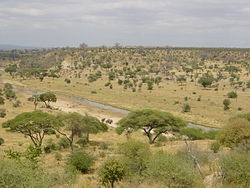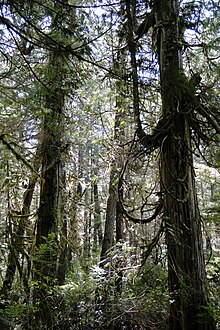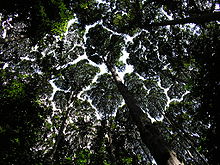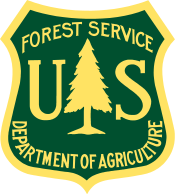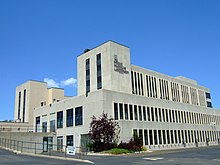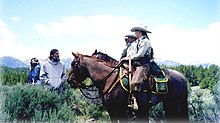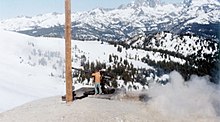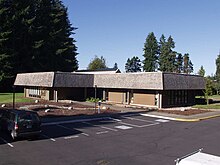Typical tropical savanna in Northern Australia demonstrating the high tree density and regular spacing characteristic of many savannas
A savanna or savannah is a mixed woodland grassland ecosystem characterised by the trees being sufficiently widely spaced so that the canopy does not close. The open canopy allows sufficient light to reach the ground to support an unbroken herbaceous layer consisting primarily of grasses.
Savannas maintain an open canopy despite a high tree density.
It is often believed that savannas feature widely spaced, scattered
trees. However, in many savannas, tree densities are higher and trees
are more regularly spaced than in forests. The South American savanna types cerrado sensu stricto and cerrado dense typically have densities of trees similar to or higher than that found in South American tropical forests, with savanna ranging from 800–3300 trees per hectare (trees/ha) and adjacent forests with 800–2000 trees/ha. Similarly Guinean savanna has 129 trees/ha, compared to 103 for riparian forest,
while Eastern Australian sclerophyll forests have average tree
densities of approximately 100 per hectare, comparable to savannas in
the same region.
Savannas are also characterised by seasonal water availability,
with the majority of rainfall confined to one season; they are
associated with several types of biomes, and are frequently in a transitional zone between forest and desert or grassland. Savanna covers approximately 20% of the Earth's land area.
Etymology
The word originally entered English in 1555 as the Latin Zauana, equivalent in the orthography of the times to zavana (see history of V). Peter Martyr reported it as the local name for the plain around Comagre, the court of the cacique Carlos in present-day Panama. The accounts are inexact, but this is usually placed in present-day Madugandí or at points on the nearby Guna Yala coast opposite Ustupo or on Point Mosquitos. These areas are now either given over to modern cropland or jungle.
Distribution
Tarangire National Park in Tanzania, East Africa
Many grassy landscapes and mixed communities of trees, shrubs, and
grasses were described as savanna before the middle of the 19th century,
when the concept of a tropical savanna climate became established. The Köppen climate classification
system was strongly influenced by effects of temperature and
precipitation upon tree growth, and his oversimplified assumptions
resulted in a tropical savanna classification concept which resulted in
it being considered as a "climatic climax" formation. The common usage
meaning to describe vegetation now conflicts with a simplified yet
widespread climatic concept meaning. The divergence has sometimes caused
areas such as extensive savannas north and south of the Congo and Amazon Rivers to be excluded from mapped savanna categories.
"Barrens" has been used almost interchangeably with savanna in
different parts of North America. Sometimes midwestern savanna were
described as "grassland with trees". Different authors have defined the
lower limits of savanna tree coverage as 5–10% and upper limits range as
25–80% of an area.
Two factors common to all savanna environments are rainfall variations from year to year, and dry season wildfires. In the Americas, e.g. in Belize, Central America, savanna vegetation is similar from Mexico to South America and to the Caribbean.
Over many large tropical areas, the dominant biome (forest,
savanna or grassland) can not be predicted only by the climate, as
historical events plays also a key role, for example, fire activity. In some areas, indeed, it is possible the occurrence of multiple stable biomes.
Threats
Changes in fire management
Savannas are subject to regular wildfires and the ecosystem appears to be the result of human use of fire. For example, Native Americans created the Pre-Columbian savannas of North America by periodically burning where fire-resistant plants were the dominant species. Pine barrens in scattered locations from New Jersey to coastal New England
are remnants of these savannas. Aboriginal burning appears to have been
responsible for the widespread occurrence of savanna in tropical Australia and New Guinea, and savannas in India are a result of human fire use. The maquis shrub savannas of the Mediterranean region were likewise created and maintained by anthropogenic fire.
Prescribed burn; Wisconsin bur oak savanna
These fires are usually confined to the herbaceous layer
and do little long term damage to mature trees. However, these fires
either kill or suppress tree seedlings, thus preventing the
establishment of a continuous tree canopy which would prevent further
grass growth. Prior to European settlement aboriginal land use
practices, including fire, influenced vegetation and may have maintained and modified savanna flora. It has been suggested by many authors
that aboriginal burning created a structurally more open savanna
landscape. Aboriginal burning certainly created a habitat mosaic that
probably increased biodiversity and changed the structure of woodlands
and geographic range of numerous woodland species. It has been suggested by many authors
that with the removal or alteration of traditional burning regimes many
savannas are being replaced by forest and shrub thickets with little
herbaceous layer.
The consumption of herbage by introduced grazers in savanna
woodlands has led to a reduction in the amount of fuel available for
burning and resulted in fewer and cooler fires. The introduction of exotic pasture legumes
has also led to a reduction in the need to burn to produce a flush of
green growth because legumes retain high nutrient levels throughout the
year, and because fires can have a negative impact on legume populations
which causes a reluctance to burn.
Grazing and browsing animals
The closed forest types such as broadleaf forests and rainforests are
usually not grazed owing to the closed structure precluding grass
growth, and hence offering little opportunity for grazing.
In contrast the open structure of savannas allows the growth of a
herbaceous layer and are commonly used for grazing domestic livestock.
As a result, much of the world's savannas have undergone change as a
result of grazing by sheep, goats and cattle, ranging from changes in
pasture composition to woody weed encroachment.
The removal of grass by grazing affects the woody plant component
of woodland systems in two major ways. Grasses compete with woody
plants for water in the topsoil and removal by grazing reduces this
competitive effect, potentially boosting tree growth.
In addition to this effect, the removal of fuel reduces both the
intensity and the frequency of fires which may control woody plant
species.
Grazing animals can have a more direct effect on woody plants by the
browsing of palatable woody species. There is evidence that unpalatable
woody plants have increased under grazing in savannas.
Grazing also promotes the spread of weeds in savannas by the removal or
reduction of the plants which would normally compete with potential
weeds and hinder establishment. In addition to this, cattle and horses are implicated in the spread of the seeds of weed species such as Prickly Acacia (Acacia nilotica) and Stylo (Stylosanthes spp.).
Alterations in savanna species composition brought about by grazing can
alter ecosystem function, and are exacerbated by overgrazing and poor
land management practices.
Introduced grazing animals can also affect soil condition through
physical compaction and break-up of the soil caused by the hooves of
animals and through the erosion effects caused by the removal of
protective plant cover. Such effects are most likely to occur on land
subjected to repeated and heavy grazing.
The effects of overstocking are often worst on soils of low fertility
and in low rainfall areas below 500 mm, as most soil nutrients in these
areas tend to be concentrated in the surface so any movement of soils
can lead to severe degradation. Alteration in soil structure and
nutrient levels affects the establishment, growth and survival of plant
species and in turn can lead to a change in woodland structure and
composition.
Tree clearing
Large areas of Australian and South American savannas have been
cleared of trees, and this clearing is continuing today. For example,
until recently 480,000 ha of savanna were cleared annually in Australia alone primarily to improve pasture production.
Substantial savanna areas have been cleared of woody vegetation and
much of the area that remains today is vegetation that has been
disturbed by either clearing or thinning at some point in the past.
Clearing is carried out by the grazing industry in an attempt to
increase the quality and quantity of feed available for stock and to
improve the management of livestock. The removal of trees from savanna
land removes the competition for water from the grasses present, and can
lead to a two to fourfold increase in pasture production, as well as
improving the quality of the feed available. Since stock carrying capacity is strongly correlated with herbage yield, there can be major financial benefits from the removal of trees,
such as assisting with grazing management: regions of dense tree and
shrub cover harbors predators, leading to increased stock losses, for
example, while woody plant cover hinders mustering in both sheep and cattle areas.
A number of techniques have been employed to clear or kill woody plants in savannas. Early pastoralists used felling and girdling, the removal of a ring of bark and sapwood, as a means of clearing land.
In the 1950s arboricides suitable for stem injection were developed.
War-surplus heavy machinery was made available, and these were used for
either pushing timber, or for pulling using a chain and ball strung
between two machines. These two new methods of timber control, along
with the introduction and widespread adoption of several new pasture
grasses and legumes promoted a resurgence in tree clearing. The 1980s
also saw the release of soil-applied arboricides, notably tebuthiuron, that could be utilised without cutting and injecting each individual tree.
In many ways "artificial" clearing, particularly pulling, mimics
the effects of fire and, in savannas adapted to regeneration after fire
as most Queensland savannas are, there is a similar response to that
after fire.
Tree clearing in many savanna communities, although causing a dramatic
reduction in basal area and canopy cover, often leaves a high percentage
of woody plants alive either as seedlings too small to be affected or
as plants capable of re-sprouting from lignotubers and broken stumps. A
population of woody plants equal to half or more of the original number
often remains following pulling of eucalypt communities, even if all the
trees over 5 metres are uprooted completely.
Exotic plant species
Acacia savanna, Taita Hills Wildlife Sanctuary, Kenya.
A number of exotic plants species have been introduced to the
savannas around the world. Amongst the woody plant species are serious
environmental weeds such as Prickly Acacia (Acacia nilotica), Rubbervine (Cryptostegia grandiflora), Mesquite (Prosopis spp.), Lantana (Lantana camara and L. montevidensis) and Prickly Pear (Opuntia
spp.) A range of herbaceous species have also been introduced to these
woodlands, either deliberately or accidentally including Rhodes grass
and other Chloris species, Buffel grass (Cenchrus ciliaris), Giant rat's tail grass (Sporobolus pyramidalis) parthenium (Parthenium hysterophorus) and stylos (Stylosanthes spp.) and other legumes.
These introductions have the potential to significantly alter the
structure and composition of savannas worldwide, and have already done
so in many areas through a number of processes including altering the
fire regime, increasing grazing pressure, competing with native
vegetation and occupying previously vacant ecological niches.
Other plant species include: white sage, spotted cactus, cotton seed, rosemary.
Climate change
Human induced climate change resulting from the greenhouse effect may result in an alteration of the structure and function of savannas. Some authors have suggested that savannas and grasslands may become even more susceptible to woody plant encroachment as a result of greenhouse induced climate change.
However, a recent case described a savanna increasing its range at the
expense of forest in response to climate variation, and potential exists
for similar rapid, dramatic shifts in vegetation distribution as a
result of global climate change, particularly at ecotones such as
savannas so often represent.
Savanna ecoregions
Savanna ecoregions are of several different types:
- Tropical and subtropical savannas are classified with tropical and subtropical grasslands and shrublands as the tropical and subtropical grasslands, savannas, and shrublands biome. The savannas of Africa, including the Serengeti, famous for its wildlife, are typical of this type. The Brazilian savanna (Cerrado) is also included in this category, known for its exotic and varied flora.
- Temperate savannas are mid-latitude savannas with wetter summers and drier winters. They are classified with temperate savannas and shrublands as the temperate grasslands, savannas, and shrublands biome, that for example cover much of the Great Plains of the United States.
- Mediterranean savannas are mid-latitude savannas in Mediterranean climate regions, with mild, rainy winters and hot, dry summers, part of the Mediterranean forests, woodlands, and scrub biome. The oak tree savannas of California, part of the California chaparral and woodlands ecoregion, fall into this category.
- Flooded savannas are savannas that are flooded seasonally or year-round. They are classified with flooded savannas as the flooded grasslands and savannas biome, which occurs mostly in the tropics and subtropics.
- Montane savannas are mid- to high-altitude savannas, located in a few spots around the world's high mountain regions, part of the montane grasslands and shrublands biome. The Bogotá savanna, located at an average altitude of 2,550 metres (8,370 ft) on the Altiplano Cundiboyacense, Eastern Ranges of the Andes, is an example of a montane savanna. The savannas of the Angolan Scarp savanna and woodlands ecoregion are a lower altitude example, up to 1,000 metres (3,300 ft).

